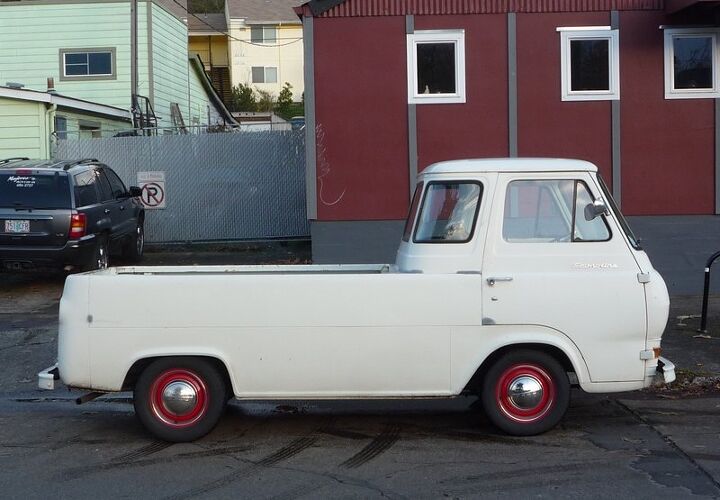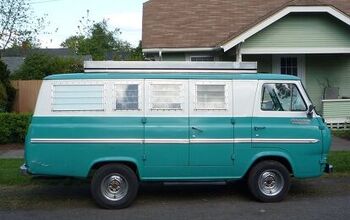Curbside Classic: 1963 Ford Econoline Pickup

History does tend to repeat itself, especially in the car business. Detroit’s more recent efforts to compete with import compact trucks was once a serious undertaking, and is now quickly dwindling away to nothing. The same thing happened once before, in the early sixties. In response to real (or imagined) incursions into the light truck field by imports, Detroit launched a barrage of new compact vans and trucks. Ford was the most prolific in the 1960-1961 period, offering no less than three distinct types of pickups. The most creative and nontraditional one was the Econoline pickup. Not surprisingly, it was the least successful (of Ford’s three types), and petered out after a few years. Americans know how they like their Ford trucks, and the Econoline was not it
Of course, the Econoline van and pickup, as well as the Corvair and the later Dodge versions were all inspired by the VW Bus and pickup (coming very soon here). The VW pickup probably wasn’t really that much of a threat due to the 25% “chicken tax” that kept sales mainly confined to VW dealers as parts haulers and a few die-hards. But the raging success of the VW Beetle and to some extent the VW bus put Detroit on edge, and largely precipitated the creative rush of compact cars and trucks that all came gushing forth in ’60 and ’61.
Ford and Chevrolet based their new compact vans and trucks on their respective new compact cars, the Falcon and Corvair. And just like with the car versions, the pragmatic and utterly conventional, simple and cheap to build RWD Falcon trounced the adventurous rear-engined air-cooled Corvair in the car segment, so did their offshoot trucks. The Econoline van instantly became the best seller in the field, and Chevy quickly cobbled up a Chevy-II based van-only version to compete (CC here), and Dodge followed the same steps with their D-100 Van and pickup. Obviously, the Corvair van’s inherent advantages of drastically better traction, braking and handling were offset by its lack of a flat floor throughout.
It doesn’t take more than a casual glance at the Econoline pickup to tell that it has a serious weight distribution problem. Ford installed a 165lb weight over the rear wheels in a effort to mitigate the problem, but lets just say this is not the thing to take out in the snow. But it was remarkably compact, yeat it sported a 7.5 foot long bed and a roomy cab with storage behind the rear seats; essentially the first extended cab pickup ever. And it was economical to run , with its light weight offering modest resistance to the little 144 and 170 cubic inch sixes. Ford claimed that up to 30 mpg in its ads.
The Econoline pickup faced a lot of internal competition as well as external. In 1960, Ford relaunched the Ranchero as a Falcon. And a conventional F-100 cost some $86 more. That left a pretty compact niche left, and public utilities turned out to be the big buyers of the little Econoline and Corvair pickups. Phone companies loved the space efficiency and low operating costs. But even then, after first year sales of 14k Econole pickups, their sales steadily dwindled, down to two thousand in their final year, 1967. That pretty much coincides with the birth of Japanese small pickup sales on the west coast.
I’ve always been drawn to these trucks for their compact size yet roomy cabs, despite their limitations. Of course, as the former owner of a Dodge A-100 van, I can well imagine what they handled like with another couple hundred pounds less in the rear quarters. And the front crush zone is a comparable to a can of Orange Crush. But it makes a handy around-the-town scooter, like this one, which is the daily driver of Joe, who does superb vintage restoration work on European cars out of his small shop. He picked it up recently, rebuilt the tired 170 six, and will eventually get to the body. Don’t ask why, but I love the exhaust sound of that little Falcon six, a pleasant mixture of nasal smoothness with an overlay of raspiness.
For some reason, this is a vehicle that I can’t quite take my eyes off: the combination of its odd proportions that challenge the conventions, and its jaunty cuteness. It’s also an extremely European-looking vehicle, although pickups in the American sense just weren’t hardly a reality there. And those red wheels don’t hurt either. These pickups may have been a sales dud, but they sure brightened up our carscape in their day. And today. Enjoy.

More by Paul Niedermeyer
Latest Car Reviews
Read moreLatest Product Reviews
Read moreRecent Comments
- Jalop1991 In a manner similar to PHEV being the correct answer, I declare RPVs to be the correct answer here.We're doing it with certain aircraft; why not with cars on the ground, using hardware and tools like Telsa's "FSD" or GM's "SuperCruise" as the base?Take the local Uber driver out of the car, and put him in a professional centralized environment from where he drives me around. The system and the individual car can have awareness as well as gates, but he's responsible for the driving.Put the tech into my car, and let me buy it as needed. I need someone else to drive me home; hit the button and voila, I've hired a driver for the moment. I don't want to drive 11 hours to my vacation spot; hire the remote pilot for that. When I get there, I have my car and he's still at his normal location, piloting cars for other people.The system would allow for driver rest period, like what's required for truckers, so I might end up with multiple people driving me to the coast. I don't care. And they don't have to be physically with me, therefore they can be way cheaper.Charge taxi-type per-mile rates. For long drives, offer per-trip rates. Offer subscriptions, including miles/hours. Whatever.(And for grins, dress the remote pilots all as Johnnie.)Start this out with big rigs. Take the trucker away from the long haul driving, and let him be there for emergencies and the short haul parts of the trip.And in a manner similar to PHEVs being discredited, I fully expect to be razzed for this brilliant idea (not unlike how Alan Kay wasn't recognized until many many years later for his Dynabook vision).
- B-BodyBuick84 Not afraid of AV's as I highly doubt they will ever be %100 viable for our roads. Stop-and-go downtown city or rush hour highway traffic? I can see that, but otherwise there's simply too many variables. Bad weather conditions, faded road lines or markings, reflective surfaces with glare, etc. There's also the issue of cultural norms. About a decade ago there was actually an online test called 'The Morality Machine' one could do online where you were in control of an AV and choose what action to take when a crash was inevitable. I think something like 2.5 million people across the world participated? For example, do you hit and most likely kill the elderly couple strolling across the crosswalk or crash the vehicle into a cement barrier and almost certainly cause the death of the vehicle occupants? What if it's a parent and child? In N. America 98% of people choose to hit the elderly couple and save themselves while in Asia, the exact opposite happened where 98% choose to hit the parent and child. Why? Cultural differences. Asia puts a lot of emphasis on respecting their elderly while N. America has a culture of 'save/ protect the children'. Are these AV's going to respect that culture? Is a VW Jetta or Buick Envision AV going to have different programming depending on whether it's sold in Canada or Taiwan? how's that going to effect legislation and legal battles when a crash inevitibly does happen? These are the true barriers to mass AV adoption, and in the 10 years since that test came out, there has been zero answers or progress on this matter. So no, I'm not afraid of AV's simply because with the exception of a few specific situations, most avenues are going to prove to be a dead-end for automakers.
- Mike Bradley Autonomous cars were developed in Silicon Valley. For new products there, the standard business plan is to put a barely-functioning product on the market right away and wait for the early-adopter customers to find the flaws. That's exactly what's happened. Detroit's plan is pretty much the opposite, but Detroit isn't developing this product. That's why dealers, for instance, haven't been trained in the cars.
- Dartman https://apnews.com/article/artificial-intelligence-fighter-jets-air-force-6a1100c96a73ca9b7f41cbd6a2753fdaAutonomous/Ai is here now. The question is implementation and acceptance.
- FreedMike If Dodge were smart - and I don't think they are - they'd spend their money refreshing and reworking the Durango (which I think is entering model year 3,221), versus going down the same "stuff 'em full of motor and give 'em cool new paint options" path. That's the approach they used with the Charger and Challenger, and both those models are dead. The Durango is still a strong product in a strong market; why not keep it fresher?








































Comments
Join the conversation
Bruce Berry was a working man He used to load that Econoline van. A sparkle was in his eye But his life was in his hands.
The test driver for dodges Little Red Wagon actually got the right to build them from Dodge when they gave up on the project so he built more than a few for those that had the money or were his friends I happen to end up with one of those but it was the Ford falcon van and they had installed a 472 Cadillac Mid Engine setup into it. It had a 12 inch drive shaft and the exhaust came off the headers almost made a right hand turn or left hand turn depending on what side you were on and dumped exhaust in front of the back tire it was a cute little orange van with 4-in flowers on the back and 12 inch firestones squished underneath, and then we found the wheelie bars or what was left of them they just charge them off at the rear of the van one of the coolest engineering fees I've ever seen, it had dual radiators it had aircraft steel cable that was connected from the engine block to the frame in case a motor mount broke, it was subframed the engine sat behind the seats inside the van it was so cool